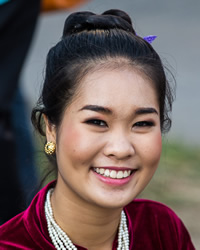Tai Kao in Laos

Photo Source:
John Shedrick - Flickr
Creative Commons
|
Send Joshua Project a map of this people group.
|
| People Name: | Tai Kao |
| Country: | Laos |
| 10/40 Window: | Yes |
| Population: | 112,000 |
| World Population: | 490,000 |
| Primary Language: | Tai Don |
| Primary Religion: | Ethnic Religions |
| Christian Adherents: | 0.00 % |
| Evangelicals: | 0.00 % |
| Scripture: | New Testament |
| Ministry Resources: | Yes |
| Jesus Film: | Yes |
| Audio Recordings: | Yes |
| People Cluster: | Tai |
| Affinity Bloc: | Southeast Asian Peoples |
| Progress Level: |
|
Introduction / History
The White Tai speak a tonal language, Tai Kao. They are members of a larger cultural-linguistic group of Tai peoples that includes the Laotians, the Shan, and others.
They are an influential people who inhabit the narrow upland valleys of northeastern Laos.
Centuries ago, the Tai Kao lived in China. Relentless pressure by the Chinese gradually forced them southward. Eventually they settled along the Red and Black Rivers, where they settled near the Honghe River. In Laos they are called Tai Kao but in neighboring Vietnam they are called Tai Don.
What Are Their Lives Like?
The Tai Kao are extremely polite, respectful, and hospitable. Their children are brought up to respect those of a higher rank and to become self-reliant individuals. Age is highly respected in Tai Kao society. Type of occupation, wealth, and place and type of residence, follow age in terms of respect and rank. Rural farmers rank below craftsmen, merchants, and city government officials; and clergy are a separate group.
Families are the core of Tai Kao society. In rural areas, the entire immediate family lives together with mutual respect for each other. A young married couple may live with the wife's family until they can establish their own home. The father is the head of the family, and Tai Kao husbands and wives appear to have a harmonious relationship. In fact, the Tai Kao are distinguished by an almost equal division of labor by sex. Both men and women plow, fish, cook, tend to the babies, clean house and wash clothes.
The Tai Kao live in small, self-governing villages that are usually limited to a single valley. Each village is under the control of the chao muong, or prince, to whom the commoners pay taxes. Although the Tai Kao are Laotian citizens, they have very little say so in the government.
Most of the Tai Kao live on small valley farms, where they grow wet rice using irrigation and terraces. They grow opium as a cash crop. The construction of new roads has helped increase accessibility to the rural areas. Chinese shops have opened in several market towns and Chinese merchants often visit Tai Kao villages to do business.
What Are Their Beliefs?
Over half of the Tai Kao combine folk animism (belief that non-living objects have spirits) with Buddhism. They worship various spirits and objects, and also believe that people have multiple personal souls. They hold ceremonies for recalling the souls because they believe that this will strengthen the individual personality. The Tai Kao believe in spirits of the dead, the natural world, the political world, various localities, etc.
They also believe in a supreme god who is active in their lives. According to their legends, their ancestors came out of a pumpkin in which they took refuge during a divinely decreed flood that drowned everyone on earth.
What Are Their Needs?
The Tai Don people need spiritual hunger. They are satisfied with the spirituality of their ancestors, one which leaves them devoid of the grace, mercy and forgiveness of the only savior. There might be no Christ followers among them in Laos.
Prayer Points
Pray for someone to explain the gospel to the Tai Kao people in a way they can understand it without compromising the gospel message.
Ask the Lord of the harvest to send loving and dedicated laborers into Laos to minister to the needs of the Tai Kao.
Pray that soon there will be Tai Kao disciples making more disciples for the glory of Christ.
Ask the Holy Spirit to soften the hearts of the Tai Kao towards the gospel and give them spiritual hunger.